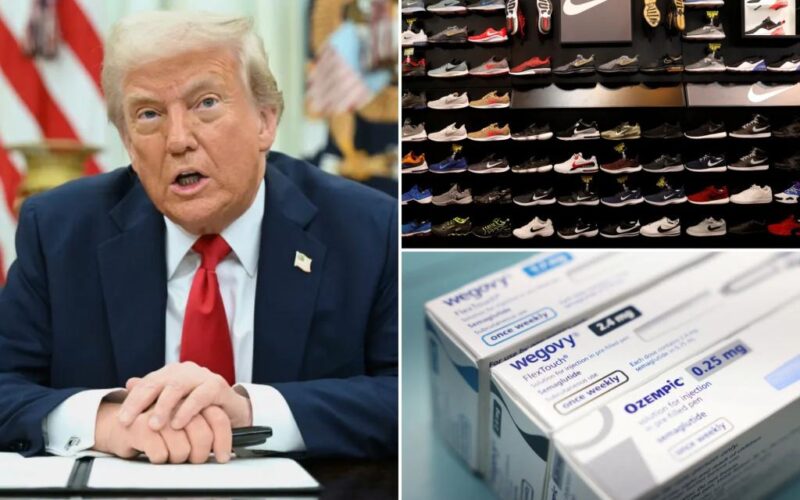President Donald Trump is poised to impose his most dramatic batch of tariffs yet — and investors, businesses and shoppers worldwide were still in the dark as they braced for “Liberation Day.”
It’s still unclear exactly what Trump will announce on Wednesday in the Rose Garden, where the White House says the president will unveil a plan for trade taxes that could unleash seismic effects across the global economy.
A key possibility is so-called reciprocal tariffs, which would vary country by country depending on local levies, according to reports. Another proposal that White House aides have drafted is to levy tariffs of roughly 20% on nearly all imports, according to a report.
The latter option “would be very much unprecedented” — and would carry a swift impact for businesses consumers alike, Sina Golara, supply chain management professor at Georgia State’s business school, told The Post.
“This will have an almost immediate impact on prices,” Golara said. “At 20%, that could impact trillions of dollars of goods.”
If Trump followed through on a broad-based 20% levy, it would cost the average household between $3,400 to $4,200 in lost purchasing power, according to a report from Yale University’s Budget Lab.
The White House did not immediately respond to The Post’s request for comment.
Whether it’s reciprocal tariffs or a 20% across-the-board levy, the tax represents a huge shift from current trade policy, as the US stares down major trade deficits with dozens of nations.
Following China and Mexico, Vietnam has the next largest US goods trade deficit at $123.5 billion in 2024 – an 18.1% jump from the year before, according to the World Trade Organization.
According to the World Trade Organization’s MFNs, which are standard rates that apply unless countries have other specific trade agreements, the US simple average tariff on Vietnam in 2024 was 3.6% – far below Vietnam’s 9% rate.
If the US hiked that rate to 20%, it could spark soaring prices on goods the US gets from Vietnam including electrical machinery and clothing. The latter include athletic shoes like Nike, Adidas and rival sneaker brands, which rely heavily on Vietnamese production.
Ireland, meanwhile, has a notable trade surplus with the US – one of the largest of any European Union member – largely thanks to its pharmaceutical exports.
A 20% tariff could send prices on popular weight-loss drugs Ozempic and Wegovy sky-high, as Danish drugmaker Novo Nordisk has expanded its facilities in Ireland.
“These tariffs will cause a short-lived inflationary shock, and the reason I say short-lived is the moment everything gets more expensive, your economic activity has to slow down,” Golara told The Post. “That will itself have a deflationary effect, but that also raises the recessionary fears, so we have to look at both sides.”
Industries with shorter supply chains – like fast-fashion giants Shein and Temu – will likely feel a price impact the quickest, Alex King, founder of personal finance site Generation Money and a former international trade VP at Barclays, told The Post.
Price pressures on industries with longer, more complex manufacturing processes like the auto sector, however, will likely lag, King added.
But in the vast majority of situations – take a dealer with cars already sitting on the lot and no extra tariff costs at the moment – companies will start to hike their prices as they anticipate rising replacement costs.
Shoppers may soon see higher price tags on many pharmaceutical drugs, which are also manufactured in Switzerland, Germany and the UK en masse; food products; and electronics – all goods that the US largely imports from other nations, experts told The Post.
Stocks could also stand to suffer further losses as investors fear new inflation triggers.
Trump has signaled he’s willing to deal with the consequences, telling NBC News over the weekend that he “couldn’t care less” if auto prices shoot up due to his planned 25% tariffs on foreign-made vehicles.
The White House has listed several purposes behind the tariffs – to balance unfair trade deficits, raise revenue for the federal budget, use as leverage in negotiations with other nations and boost US manufacturing.
The White House has flip-flopped on its trade policies before. Trump placed hefty tariffs on most goods from Canada and Mexico, for example, on a second month-long pause also due to expire on Wednesday.
The planned 25% taxes on Canada and Mexico, as well as a 20% levy on China that took effect in March, alone would hike the average US tariff rate by seven percentage points to just under 10% – its highest level since 1943, according to Yale’s Budget Lab.
The research center predicted that, if fully implemented, the tariffs on Canada, Mexico and China would lead to as much as $2,000 in additional costs per US household.
Trump has charged full steam ahead on his tariff mission since taking office, imposing 25% levies on steel and aluminum imports on March 12, and announcing his plan for auto tariffs on March 26.
The White House plans to tax fully-assembled foreign vehicles starting Thursday, and follow up with tariffs on auto parts by May 3.
Sector-specific tariffs on semiconductors, pharmaceuticals, food and copper have also been floated as possibilities by the Trump administration.
Wall Street rallied last week after Trump hinted he may target just a specific group of nations dubbed the “dirty 15” – about 15% of nations designated as particular trade abusers, according to Treasury Secretary Scott Bessent.
The exact countries included in that list are unclear, though it will likely include nations like Australia, Brazil, Canada, China, the European Union, India, Japan, South Korea, Mexico, Russia, Vietnam and more, a source familiar with the plans told The Wall Street Journal.
But later that day, Trump doubled down on his promise to target all countries with reciprocal taxes, spooking investors once more.








